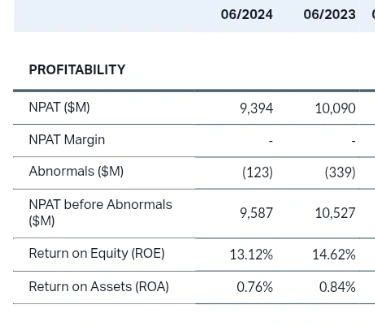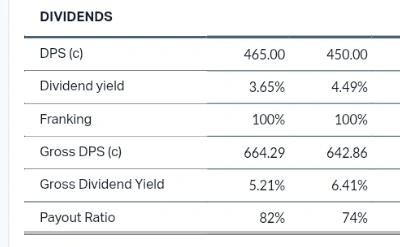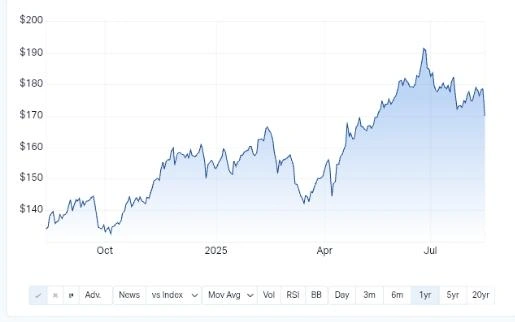The Commonwealth Bank of Australia (CBA) has delivered strong results in FY25 despite worldwide volatility.
The bank earned a statutory net profit after tax (NPAT) of $10.13 billion. Cash NPAT was $10.25 billion, up 4% from FY24.
Favourable performance was a consequence of growth in lending, steady net interest margin, and lower loan impairment expenses.

Profitability for year 2023 & 2024
What Drove CBA’s Profit Growth?
Pre-provision profits grew by 3% to $15.47 billion. An indication of strong operational performance across its domestic businesses.
Net interest margin stood at 2.08%, 9 basis points higher than FY24. Higher earnings from capital and portfolio hedges supported margins.
This was partially offset by deposit competition. Operating expenses increased 6% to $12.99 billion.
This was primarily due to inflationary pressures, accelerated investment in technology, and the hiring of additional frontline staff.
Investment spend was $2.30 billion, up 14% on FY24. The spend relates to technology modernisation and strengthening generative AI capabilities.
Dividend Increases to $4.85 Per Share
A final dividend of $2.60 per share, fully franked, has been declared by CBA. This increments the full-year dividend to $4.85, an increase of 4% for FY24.
79% of cash NPAT was the payout ratio; it stood at the higher end of the target range.
The shares to satisfy the Dividend Reinvestment Plan will be acquired via on-market purchases.

Dividend Analysis for year 2023 & 2024
How Strong Is CBA’s Balance Sheet?
With respect to Common Equity Tier 1 (CET1) capital, the ratio stood at 12.3%, above the regulatory requirement of 10.25%.
The bank has completed $300 million out of a planned $1 billion buy-back. The buy-back period has been extended for 12 months.
Return on equity remained quite strong at 13.5%. Funding remained strong with a 78% deposit funding ratio.
The liquidity coverage ratio was 130%, and the net stable funding ratio was 115%. Both well and truly above the regulatory minimum.
CBA’s Economic and Market Outlook
Modest economic growth is expected as we approach 2026. The Australian economy has been able to stay afloat with a firm labour market, steady immigration, and sustained public investment.
Households benefited from the lower rates, lower inflation, and tax reductions.
The bank observes conservative financial settings so that upon the arrival of any scenario, it would be ready.
The Australian banking sector is forecast to reach retail deposits in excess of $1 trillion by 2026.
Steady investor confidence is maintained in the sector due to strong capital positions.
The bank will probably maintain market shares through its digital banking and customer engagement leadership.

ASX share Chart
What Actions Did CBA Take for Customers?
More than 139,000 tailored payment arrangements were supported by the bank for customers frustrated with one or more payments.
It provided protection against fraud, scams, and cybercrimes to the extent of $900 million. Customer losses to scams have fallen by 76% since the peak.
The CommBank app sends up to 35,000 suspicious transaction alerts daily. In FY25, CBA assisted 140,000 households in buying homes, including for first-time buyers.
It has paid more than $22 billion in interest to savers. Regional branches will thus remain open till at least mid-2027. The bank disbursed grants of $20,000 each for 175 community organisations.
Investor Sentiment Remains Positive
Distributing $8 billion in shareholder returns to more than 13 million individuals in Australia. It also paid $5 billion in taxes, thus cementing its position as one of Australia’s largest corporate taxpayers.
Strong credit quality sustains investor confidence: loan impairment expenses of $726 million.
Home loan arrears have remained largely stable, with 85% of borrowers making repayments ahead of time. Analysts observe that capital strength, coupled with a digital strategy, positions CBA well in the face of global headwinds.
Long-term wholesale funding maturity averages 5.1 years and speaks to its conservative liquidity stance.
Also Read: SGH Reports Target-Beating FY25 Earnings Growth
CBA Maintains Market Leadership with Strong FY25 Performance
Resilient Commonwealth Bank of Australia FY25 results, which provide for strong returns for their shareholders.
Cash NPAT is $10.25 billion, dividends stand at $4.85, and solid capital ratios are all seen by the CBA as worthy of being called a marketplace leader.
Investing in technology, fraud prevention, and customer support ensures C BA will remain aligned with key growth opportunities in Australia’s banking sector.












